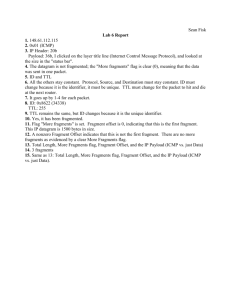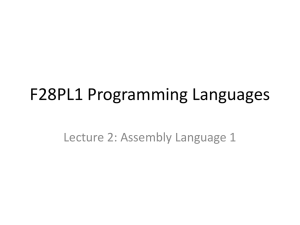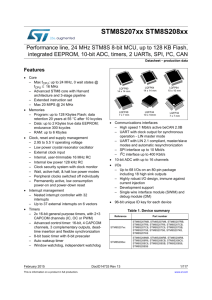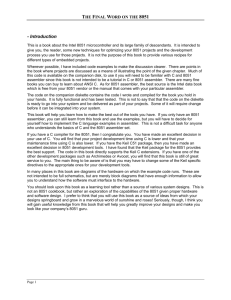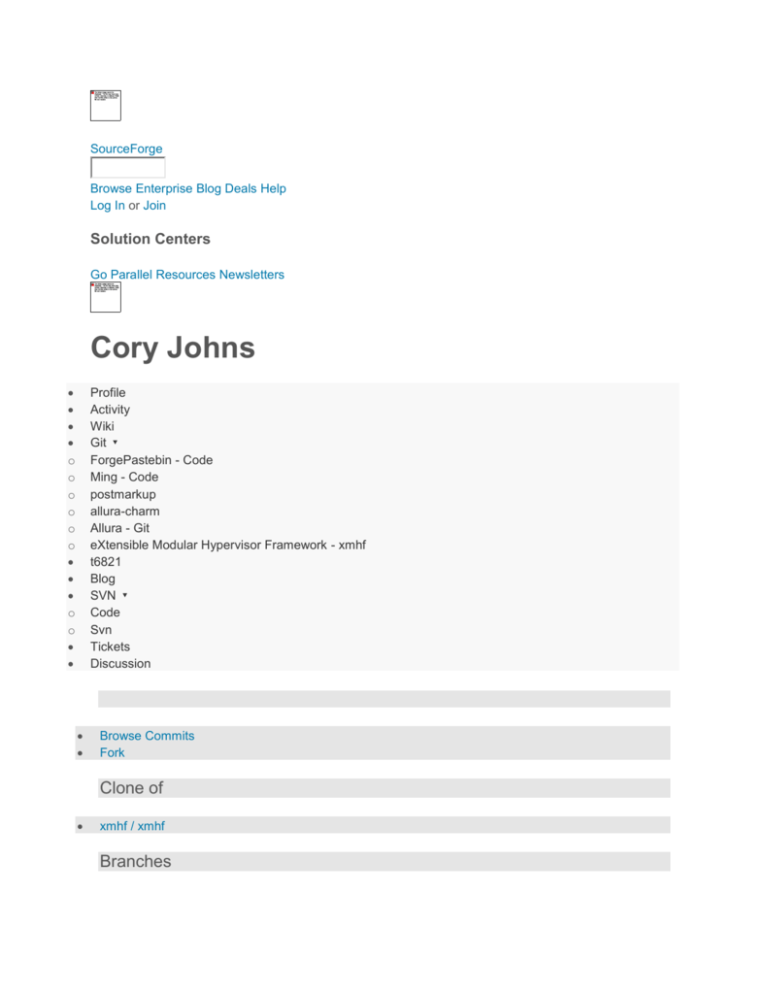
SourceForge
Browse Enterprise Blog Deals Help
Log In or Join
Solution Centers
Go Parallel Resources Newsletters
Cory Johns
o
o
o
o
o
o
o
o
Profile
Activity
Wiki
Git ▾
ForgePastebin - Code
Ming - Code
postmarkup
allura-charm
Allura - Git
eXtensible Modular Hypervisor Framework - xmhf
t6821
Blog
SVN ▾
Code
Svn
Tickets
Discussion
Browse Commits
Fork
Clone of
xmhf / xmhf
Branches
master
ticket-75
Tags
v0.1
v0.1.1
v0.1.2
v0.2
v0.2.1
v0.2.2
[a027f1]: hypapps / trustvisor / tee-sdk / ports / openssl / openssl-1.0.0d /
crypto / rc2 / rrc2.doc Maximize History
Download this file
220 lines (162 with data), 9.8 kB
>From
cygnus.mincom.oz.au!minbne.mincom.oz.au!bunyip.cc.uq.oz.au!munnari.OZ.AU!co
mp.vuw.ac.nz!waikato!auckland.ac.nz!news Mon Feb 12 18:48:17 EST 1996
Article 23601 of sci.crypt:
Path:
cygnus.mincom.oz.au!minbne.mincom.oz.au!bunyip.cc.uq.oz.au!munnari.OZ.AU!co
mp.vuw.ac.nz!waikato!auckland.ac.nz!news
>From: pgut01@cs.auckland.ac.nz (Peter Gutmann)
Newsgroups: sci.crypt
Subject: Specification for Ron Rivests Cipher No.2
Date: 11 Feb 1996 06:45:03 GMT
Organization: University of Auckland
Lines: 203
Sender: pgut01@cs.auckland.ac.nz (Peter Gutmann)
Message-ID: <4fk39f$f70@net.auckland.ac.nz>
NNTP-Posting-Host: cs26.cs.auckland.ac.nz
X-Newsreader: NN version 6.5.0 #3 (NOV)
Ron Rivest's Cipher No.2
-----------------------Ron Rivest's Cipher No.2 (hereafter referred to as RRC.2, other people may
refer to it by other names) is word oriented, operating on a block of 64
bits
divided into four 16-bit words, with a key table of 64 words. All data
units
are little-endian. This functional description of the algorithm is based
in
the paper "The RC5 Encryption Algorithm" (RC5 is a trademark of RSADSI),
using
the same general layout, terminology, and pseudocode style.
Notation and RRC.2 Primitive Operations
RRC.2 uses the following primitive operations:
1. Two's-complement addition of words, denoted by "+". The inverse
operation,
subtraction, is denoted by "-".
2. Bitwise exclusive OR, denoted by "^".
3. Bitwise AND, denoted by "&".
4. Bitwise NOT, denoted by "~".
5. A left-rotation of words; the rotation of word x left by y is denoted
x <<< y. The inverse operation, right-rotation, is denoted x >>> y.
These operations are directly and efficiently supported by most processors.
The RRC.2 Algorithm
RRC.2 consists of three components, a *key expansion* algorithm, an
*encryption* algorithm, and a *decryption* algorithm.
Key Expansion
The purpose of the key-expansion routine is to expand the user's key K to
fill
the expanded key array S, so S resembles an array of random binary words
determined by the user's secret key K.
Initialising the S-box
RRC.2 uses a single 256-byte S-box derived from the ciphertext contents of
Beale Cipher No.1 XOR'd with a one-time pad. The Beale Ciphers predate
modern
cryptography by enough time that there should be no concerns about
trapdoors
hidden in the data. They have been published widely, and the S-box can be
easily recreated from the one-time pad values and the Beale Cipher data
taken
from a standard source. To initialise the S-box:
for i = 0 to 255 do
sBox[ i ] = ( beale[ i ] mod 256 ) ^ pad[ i ]
The contents of Beale Cipher No.1 and the necessary one-time pad are given
as
an appendix at the end of this document. For efficiency, implementors may
wish
to skip the Beale Cipher expansion and store the sBox table directly.
Expanding the Secret Key to 128 Bytes
The secret key is first expanded to fill 128 bytes (64 words). The
expansion
consists of taking the sum of the first and last bytes in the user key,
looking
up the sum (modulo 256) in the S-box, and appending the result to the key.
The
operation is repeated with the second byte and new last byte of the key
until
all 128 bytes have been generated. Note that the following pseudocode
treats
the S array as an array of 128 bytes rather than 64 words.
for j = 0 to length-1 do
S[ j ] = K[ j ]
for j = length to 127 do
s[ j ] = sBox[ ( S[ j-length ] + S[ j-1 ] ) mod 256 ];
At this point it is possible to perform a truncation of the effective key
length to ease the creation of espionage-enabled software products.
However
since the author cannot conceive why anyone would want to do this, it will
not
be considered further.
The final phase of the key expansion involves replacing the first byte of S
with the entry selected from the S-box:
S[ 0 ] = sBox[ S[ 0 ] ]
Encryption
The cipher has 16 full rounds, each divided into 4 subrounds. Two of the
full
rounds perform an additional transformation on the data. Note that the
following pseudocode treats the S array as an array of 64 words rather than
128
bytes.
for i =
j = i
word0
<<< 1
word1
<<< 2
word2
<<< 3
word3
<<< 5
0 to 15 do
* 4;
= ( word0 + ( word1 & ~word3 ) + ( word2 & word3 ) + S[ j+0 ] )
= ( word1 + ( word2 & ~word0 ) + ( word3 & word0 ) + S[ j+1 ] )
= ( word2 + ( word3 & ~word1 ) + ( word0 & word1 ) + S[ j+2 ] )
= ( word3 + ( word0 & ~word2 ) + ( word1 & word2 ) + S[ j+3 ] )
In addition the fifth and eleventh rounds add the contents of the S-box
indexed
by one of the data words to another of the data words following the four
subrounds as follows:
word0
word1
word2
word3
=
=
=
=
word0
word1
word2
word3
+
+
+
+
S[
S[
S[
S[
word3
word0
word1
word2
&
&
&
&
63
63
63
63
];
];
];
];
Decryption
The decryption operation is simply the inverse of the encryption operation.
Note that the following pseudocode treats the S array as an array of 64
words
rather than 128 bytes.
for i =
j = i
word3
j+3 ]
word2
j+2 ]
word1
j+1 ]
word0
j+0 ]
15 downto 0 do
* 4;
= ( word3 >>> 5 ) - ( word0 & ~word2 ) - ( word1 & word2 ) - S[
= ( word2 >>> 3 ) - ( word3 & ~word1 ) - ( word0 & word1 ) - S[
= ( word1 >>> 2 ) - ( word2 & ~word0 ) - ( word3 & word0 ) - S[
= ( word0 >>> 1 ) - ( word1 & ~word3 ) - ( word2 & word3 ) - S[
In addition the fifth and eleventh rounds subtract the contents of the Sbox
indexed by one of the data words from another one of the data words
following
the four subrounds as follows:
word3
word2
word1
word0
=
=
=
=
word3
word2
word1
word0
-
S[
S[
S[
S[
word2
word1
word0
word3
&
&
&
&
63
63
63
63
]
]
]
]
Test Vectors
The following test vectors may be used to test the correctness of an RRC.2
implementation:
Key:
Plain:
Cipher:
Key:
Plain:
Cipher:
Key:
Plain:
Cipher:
Key:
Plain:
Cipher:
0x00,
0x00,
0x00,
0x1C,
0x00,
0x00,
0x00,
0x19,
0x00,
0x00,
0x00,
0x8A,
0x00,
0x00,
0x00,
0x83,
0x00,
0x00,
0x00,
0x8D,
0x00,
0x00,
0x00,
0xF0,
0x00,
0x00,
0x00,
0x28,
0x00,
0x00
0x00
0xB7
0x00,
0x00,
0x00,
0x21,
0x00,
0x00,
0x00,
0x82,
0x00,
0x00,
0x00,
0x9C,
0x00,
0x00,
0x00,
0x78,
0x00,
0x00,
0x00,
0xA9,
0x00,
0x00,
0x00,
0xF9,
0x00,
0x00,
0x00,
0xC0,
0x00,
0x01
0x00
0x74
0x00,
0x00,
0xFF,
0x13,
0x00,
0x00,
0xFF,
0xDB,
0x00,
0x00,
0xFF,
0x35,
0x00,
0x00,
0xFF,
0x17,
0x00,
0x00,
0xFF,
0xD3,
0x00,
0x00,
0xFF,
0x21,
0x00,
0x00,
0xFF,
0x86,
0x00,
0x00
0xFF
0x9E
0x00,
0x08,
0x00,
0x50,
0x01,
0x09,
0x00,
0xDC,
0x02,
0x0A,
0x00,
0x01,
0x03,
0x0B,
0x00,
0x62,
0x04,
0x0C,
0x00,
0xBD,
0x05,
0x0D,
0x00,
0x75,
0x06,
0x0E,
0x00,
0x7F,
0x07,
0x0F
0x00
0x31
Appendix: Beale Cipher No.1, "The Locality of the Vault", and One-time Pad
for
Creating the S-Box
Beale Cipher No.1.
71, 194,
95,
38,1701,
89,
76,
11,
83,1629,
48,
94,
63, 132,
16, 111,
84, 341, 975,
3,
126,2018,
231,
124, 211,
193,
145,
1,
176,
130, 10,
416,
280, 15,
283,
134, 92,
131,
160, 79,
12,
103, 820,
346,
36, 150,
21,
136, 872,
37,
122, 113,
680,
93, 86,
818,
2, 38,
81,
623, 48,
206
40,
14,
40,
64,
460,
81, 139, 213,
63,
90,1120,
8,
15,
74, 758, 485, 604, 230, 436, 664, 582, 150, 251, 284, 308,
486, 225, 401, 370,
94,
27,
11, 101, 305, 139, 189,
17,
33,
88, 208,
73, 416, 918, 263,
28, 500, 538, 356, 117, 136, 219,
27,
25, 485,
65,
84, 200, 283, 118, 320, 138,
36,
39,
24,
71, 224, 961,
18, 436,
44,
63, 246, 486, 682,
18,
16, 401,
88,
61, 304,
7, 219, 184, 360, 780,
73, 440,
95,
64, 581,
62, 110,
97, 103, 862,
70,
34,
18,
12,
21,
64, 463, 474,
69, 128, 367, 460,
17,
81,
60,1317, 471, 540, 208, 121, 890,
59, 568, 614,
13, 120,
63, 219, 812,2160,1780,
15,
88,
4,
30,
44, 112,
18, 147, 436, 195, 320,
8, 120, 305,
42,
58, 461,
44, 106, 301,
9, 102,
38, 416,
89,
28, 170,
6, 140,
116, 530,
82, 568,
121, 195,
14, 326, 148, 234,
961,
19,
26,
97,
64, 145, 190, 190, 117, 217, 163,
33,
18,
10,1101, 365,
99,
35,
13, 408,
71, 216, 728, 965,
55, 131, 234, 361, 824,
92,
18,
5,
88, 181, 275, 346, 201,
One-time Pad.
158,
194,
146,
161,
105,
213,
193,
67,
197,
108,
144,
134,
119,
24,
186, 223,
43, 248, 141,
70, 206, 176, 183,
3,
54,
72, 223, 233, 153,
91, 210,
120, 113, 191, 113,
86,
19, 245, 213, 221,
43,
92, 166,
215,
10,
23, 197, 112, 110, 193,
59, 218, 110, 246, 181,
127,
6,
176,
73,
6, 222, 172,
58, 135,
69,
0, 135,
80, 144,
23, 198,
36, 131, 244,
27, 242, 157,
73,
30, 156,
51, 125,
51, 158,
76, 164,
97,
87, 234,
22, 245, 207,
0, 170,
47,
70, 227, 182, 146,
32, 171, 176, 129,
91,
126, 77, 248,
0, 118, 69, 57,
84,
168, 167, 163, 102, 223, 64, 174,
38,
241, 46, 236, 31, 59, 114, 23,
182,
230, 118, 122, 86, 105, 92, 179,
44,
17, 20, 53, 153, 137, 224, 176,
20,
87, 44, 252, 20, 235, 242, 163,
97,
142, 86, 146, 221, 179, 166, 161,
155,
15, 30, 77, 216, 165, 117, 107,
127,
170, 195, 26, 84, 255, 132, 150,
99
60, 190, 171, 217,
61, 136, 169, 196,
178, 166, 239, 242, 195, 249,
50, 119, 186,
7,
66, 212,
92,
97, 222,
243, 255, 189, 223, 164, 194, 215,
100, 208, 114,
132,
74,
63,
18,
69, 182,
59,
98,
36, 200, 145, 150, 215,
5, 122,
74,
97,
34,
88, 120, 128,
58,
76,
90, 169, 127, 143, 181, 208, 137, 200,
58, 103, 250, 120, 221, 237,
37,
8,
Implementation
A non-US based programmer who has never seen any encryption code before
will
shortly be implementing RRC.2 based solely on this specification and not on
knowledge of any other encryption algorithms. Stand by.
SourceForge
About Site Status @sfnet_ops
Powered by
Apache Allura™
Find and Develop Software
Create a Project Software Directory Top Downloaded Projects
Community
Blog @sourceforge Resources
Help
Site Documentation Support Request Real-Time Support
© 2016 Slashdot Media. All Rights Reserved.
Terms Privacy Opt Out Choices Advertise

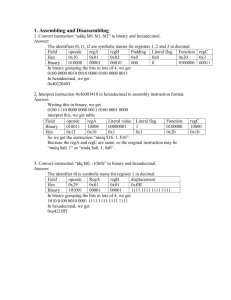

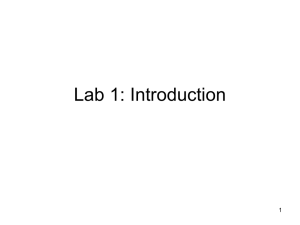
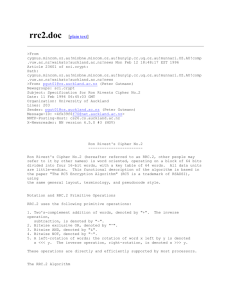
![wive-ng / wive-ng-rtnl / [aedcd0] /user/openssl/crypto/rc2/rrc2](http://s3.studylib.net/store/data/007392424_1-2c2c396659a05b01acbd844e85febbfc-300x300.png)
